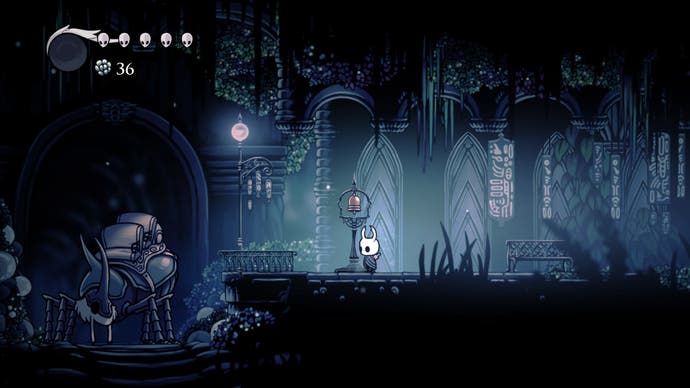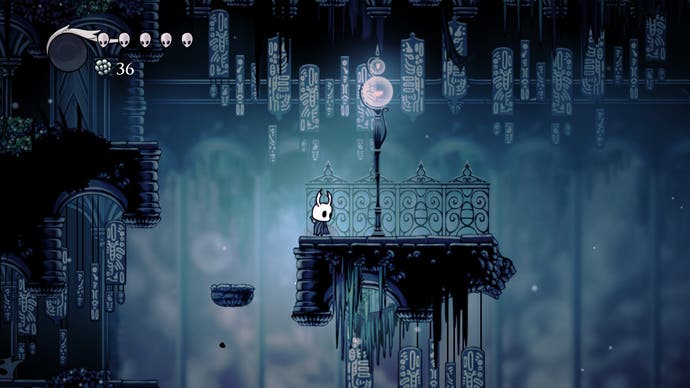Introducing the Video Game City Week
And to start things off, a look at Hollow Knight's Queen's Station.
Hello! This week we're trying something a bit special. It's Video Game City Week!
Video games are filled with cities, and one of the great pleasures of a certain kind of game is getting to explore an urban environment that's been designed especially to intrigue you and keep you busy. So we started to wonder: what are the best video game cities, including both real and imagined places? And what are the best individual pieces from those cities?
And what would a city look like if you pulled it together from your favourite elements of other video game cities? Which game would you turn to for the perfect rooftops, the perfect coffee shops, the perfect use of statues and freeways? (In a beautiful piece of synchronicity, Skyfaring author - and airline pilot - Mark Vanhoenacker's luminous Imagine a City was released last week - do track it down.)
So that's the idea: a couple of short pieces each day in which writers argue for their favourite video game city and their favourite aspect of that city. First up are the Stagways from Hollow Knight, converging in the glorious Queen's Station.
Last thing: special thanks to Lucy Grimwood for the absolutely stunning Video Game City logo art. It's just gorgeous.
We hope you enjoy these pieces, and have a think about your own favourite cities.
Queen's Station
They say the best way to arrive in a city is by train. I think that probably holds true even when the train is actually a giant stag beetle, summoned by the ring of a bell. Actually, it's perfect - Hollow Knight's fast travel Stagways system blends the best of trains and hansom cabs. Victoriana of a certain kind - the pre-raphaelites, Christina Rosetti - shimmers through this world.

And this is never clearer than at the Queen's Station, the jewel of the Stagways system. When I think of Hollow Knight, a delicate, brutal metroidvania set in the moonlit world of insects, I always think of this place. It feels like it's the centre of something vast, the way that Grand Central feels like it has arteries and veins open to the whole of New York. It's a place you pass through, and yet it's also a place that rewards stopping to take a break. Of all of the railway stations in video games, The Queen's Station is my favourite.
This is perhaps in part because it orients me, as a good train station should. In Hollow Knight I am often flung far across the map, following threads I can barely keep track of and cowering from the next boss. Just knowing the Queen's Station is there - always within relatively easy reach - give me the pluck I need to explore just a little further.

Like a lot of train stations it's a place of abstract usefulness, an idea of a place as much as a place in its own right - it's primarily a spot on the map. I have a sense of it - moonlight on railings, old stone, banners written in languages I cannot read - but in order to write this piece I decided to go back there, and not just spend a few minutes taking it in, but also snap a few pictures, so that I could see the place afresh, one screen at a time.
Here is what I learned. The Queen's Station is not just a beauty of the gilded age. It is in disrepair, with the odd piece of railing askew, the odd banner in tatters. It is stone and glinting metal, but the meadow is creeping back in - ivy clusters under the milky light of the lamps, each one housing a tiny shining creature, while one area is turned into a navigation puzzle by dense creepers and their sharp pink spines.

There's an old Lincoln Preston novel, I think, which has as a location an abandoned subway station, part of a secret, privileged network that would take the rich between one hotel and another without having to mingle with us ordinary people. These places succumbed to entropy and disrepair, but they are still down there waiting for the plot to reach them - silent platforms with sagging chandeliers and gap-toothed grand pianos.
And there's something of this to the Queen's Station - a jewel, but a misty one, its brightness clouded by time. But the space itself remains alive, just sleeping. And across the course of my journeys I will have reason to visit it many times.


